Understanding Predatory Lending in Home Financing
As more individuals seek to finance their homes, awareness of predatory lending practices has become critical. These deceptive and exploitative tactics can trap borrowers in unaffordable loans, often targeting vulnerable populations. This article guides readers through the essential aspects of mortgage brokerage and residential lending services while illuminating the warning signs and consequences of predatory lending to help consumers protect their financial futures.
Mortgage Brokerage and Residential Lending Services: Roles and Processes

What are mortgage brokerage services?
Mortgage brokerage services act as intermediaries between homebuyers and a variety of lenders. Mortgage brokers assess clients' financial situations, help gather necessary documentation, and assist in completing and submitting loan applications. They negotiate favorable loan terms and interest rates on behalf of their clients, often accessing a wider range of lenders than an individual borrower could approach alone.
These services provide cost savings and guidance through the complex financing process. By simplifying steps and offering access to diverse loan options, mortgage brokers help clients find the best mortgage suited to their needs.
What do residential lending services include?
Residential lending services consist of providing mortgage loans to assist people in purchasing, refinancing, or tapping into equity in their homes. This process involves different players:
- Mortgage lenders such as banks, credit unions, and online lenders directly issue loans.
- Mortgage brokers act as intermediaries, connecting borrowers to suitable lenders.
- Mortgage servicers handle ongoing loan administration, including collecting payments and managing escrow accounts.
Residential lending also involves critical underwriting processes that verify income, employment, assets, and creditworthiness to ensure borrowers can repay loans. Understanding loan features like interest rates and repayment terms helps consumers avoid predatory lending and select appropriate financing.
How do mortgage brokers differ from direct lenders?
Mortgage brokers and direct lenders differ primarily in their roles:
| Role | Mortgage Broker | Direct Lender |
|---|---|---|
| Function | Intermediary connecting borrowers to multiple lenders | Provides loans directly to borrowers |
| Loan options | Access to a variety of loan programs and rates | Limited to their own loan products |
| Application process | Assists with paperwork and negotiations | Processes loan applications internally |
| Speed | Potentially slower due to multiple lender options | Usually quicker loan decisions |
Borrowers working with brokers enjoy more choices, while direct lenders offer more streamlined processes.
What is the typical process for obtaining a residential mortgage loan?
The mortgage loan journey usually includes these steps:
- Pre-approval: Lenders check credit, income, and debts to estimate borrowing power.
- Home search and offer: Borrowers find a property and make an offer.
- Application: A formal loan application with detailed documents is submitted.
- Processing: The lender orders appraisal, inspections, and title searches.
- Underwriting: Thorough evaluation of borrower's financial information.
- Approval: Loan approval and review of closing documents.
- Closing: Signing paperwork, paying closing costs, locking interest rate, and receiving home keys.
This structured process helps ensure the loan fits the borrower's financial profile and the property's value.
| Aspect | Description | Benefit |
|---|---|---|
| Mortgage Brokerage | Acts as middleman, offering multiple loan options | More choices, expert guidance |
| Residential Lending | Provides loans, underwriting, servicing | Facilitates home financing and loan management |
| Broker vs Lender | Brokers connect; lenders fund loans directly | Brokers offer variety; lenders offer speed |
| Loan Process Steps | Pre-approval to closing | Structured, ensures responsible lending and buying |
Identifying Predatory Lending: Red Flags and Targeted Demographics

What is Predatory Lending?
Predatory mortgage lending involves deceitful or aggressive tactics that exploit borrowers. These lenders use fraud or take unfair advantage of a borrower's lack of understanding about complex loan terms, often resulting in unfavorable conditions for the consumer.
What Are Common Deceptive Tactics?
Predatory lenders commonly offer high or adjustable interest rates, teaser rates that escalate quickly, and engage in loan flipping—repeated refinancing that increases debt. They may also charge excessive or hidden fees, inflate property appraisals, or make misleading promises like "easy credit" or "no out of pocket expenses."
Who Is Targeted by Predatory Lenders?
Typically, predatory lenders focus on vulnerable groups, including homeowners with significant equity, those facing credit challenges, or people with urgent financial needs like medical bills or home repairs. Low-income households, minorities, and the elderly are disproportionately targeted due to their economic situations or reliance on home equity.
What Warning Signs Should Borrowers Recognize?
Borrowers should watch out for:
- High-risk adjustable-rate mortgages with sharply rising payments after a short term
- Excessive or hidden fees
- Inflated property appraisals
- Pressure through high-pressure sales tactics
- Unlicensed lenders or promises of quick approval without clear terms
- Prepayment penalties lasting more than three years or costing more than six months' interest
By understanding these red flags and who is most at risk, borrowers can better protect themselves against predatory lending practices.
The Impact of Predatory Lending on Vulnerable Communities
Demographics Most Affected by Predatory Lending
Predatory lending disproportionately targets vulnerable populations, including minority groups, the elderly, and low-income households. These communities often face limited access to traditional credit, making them susceptible to loans with unfair terms. For instance, Black and Latino/Latina borrowers have been shown to receive higher-cost subprime mortgages even after controlling for risk factors. Older adults, reliant on fixed incomes and home equity, are targeted through high-interest loans and unfair refinancing offers.
Historical and Recent Social and Financial Consequences
The social and financial fallout of predatory lending has been profound. Communities burdened by excessive fees, inflated appraisals, and risky loan structures have experienced increased foreclosure rates and asset depletion. Such practices lead not only to personal financial hardship but also contribute to wider community decline. The repeat refinancing tactics and unfair terms cause borrowers to lose home equity and deepen debt.
Relationship Between Predatory Lending and the 2008 Financial Crisis
Predatory subprime mortgage lending was a significant contributor to the 2008 housing crisis. Aggressive lending to borrowers with poor credit, paired with deceptive loan terms and securitization practices, fueled a wave of foreclosures. Minority communities were disproportionately affected, suffering from lost wealth and economic instability as a result. The crisis highlighted the systemic risks of unchecked predatory practices.
Ethical Considerations of Predatory Lending Practices
Ethically, predatory lending violates principles of respect and fairness. By exploiting borrowers’ lack of understanding and prioritizing lender profit over borrower well-being, these practices treat individuals as means to an end rather than respecting their dignity. The emphasis on foreclosure and high profit margins raises serious moral questions about fairness, transparency, and social responsibility in lending.
Protecting Yourself: Choosing the Right Mortgage Broker or Lender

What factors should a borrower consider when choosing a mortgage broker or lender?
When selecting a mortgage broker or lender, it’s crucial for borrowers to carefully evaluate various factors to avoid falling victim to predatory lending. Interest rates and overall loan terms—including fees and closing costs—should be compared across multiple lenders. Borrowers should seek out options within a short span of time to spot the best deal and identify unusually high costs or risky loan features.
Equally important is researching the reputation of the lender or broker. Online reviews, regulatory records, and customer feedback can reveal red flags such as aggressive sales tactics or hidden fees. Asking detailed questions about loan structures, payment schedules, penalties, and timelines helps ensure clarity and transparency. Choosing a professional who communicates openly and supports the borrower through the process reduces risks of costly misunderstandings.
What are the benefits of using mortgage brokerage services?
Mortgage brokers bring several advantages. They typically offer access to a variety of loan products from many lenders, increasing the chances of finding a mortgage suited to different credit profiles or financial situations. Brokers also guide borrowers through paperwork and documentation requirements, saving time and reducing errors.
Moreover, brokers often negotiate loan features on the borrower’s behalf, which can result in lower interest rates, fewer fees, or more flexible terms. This expertise helps especially borrowers with credit challenges or unique financial needs find fairer deals. When working with reputable brokers—licensed and regulated professionals—borrowers gain an ally who streamlines the mortgage process and promotes financial transparency.
Role of comparisons and shopping around
Shopping around for mortgage offers is vital. Comparing multiple quotes, including detailed Good Faith Estimates, enables borrowers to evaluate interest rates, fees, points, and loan conditions side-by-side. This reduces the chance of accepting a deceptive or costly loan product.
Questions to ask lenders and brokers
- What are all the fees and closing costs?
- Are there prepayment penalties or balloon payments?
- What happens to the interest rate over time?
- Can you explain the loan terms in writing?
- Is this loan suitable given my credit and financial status?
Importance of transparency and documentation
Demand full disclosure of loan terms and insist on written documentation of all promises. Carefully review credit reports and paperwork before signing. Consumers have the right to review and cancel certain loans within days of closing, so understanding all aspects is essential for protection.
| Consideration | Explanation | Benefit |
|---|---|---|
| Interest Rates | Compare fixed, variable, and teaser rates | Identify affordable, stable loans |
| Fees and Closing Costs | Review origination charges, points, and hidden fees | Avoid excessive, unnecessary payments |
| Loan Terms | Study duration, prepayment penalties, balloon payments | Prevent surprises and costly loan features |
| Lender/Broker Reputation | Check licensing, reviews, complaint history | Choose trustworthy professionals |
| Transparency | Question unclear terms; get documents in writing | Reduce fraud, misunderstanding risks |
Common Predatory Lending Practices and Legal Protections

Typical Abusive Lending Tactics
Predatory mortgage lending encompasses numerous unfair and deceptive practices designed to exploit borrowers. Common tactics include excessive fees, loan flipping—which involves repeatedly refinancing loans to increase debt—balloon payments that demand large sums at the end of a loan term, and prepayment penalties that discourage early repayment. Other abusive actions are steering qualified borrowers into subprime or higher-cost loans and asset-based lending that ignores the borrower's ability to repay.
Role of Excessive Fees, Flipping, Balloon Payments, and Prepayment Penalties
Excessive fees, often hidden or inflated, directly increase the borrower's cost of credit. Loan flipping drains home equity by encouraging multiple refinancing without benefiting the borrower. Balloon payments create financial shocks by requiring a substantial repayment after a short period. Abusive prepayment penalties lasting over three years or costing more than six months’ interest prevent borrowers from refinancing or repaying loans early, trapping them in unfavorable terms.
Legislative and Regulatory Safeguards
To combat predatory lending, various laws and regulations are in place at federal and state levels. Notable federal legislation includes the Truth in Lending Act (TILA), the Real Estate Settlement Procedures Act (RESPA), the Home Ownership and Equity Protection Act (HOEPA), and the Dodd-Frank Act. These laws limit abusive fees, prohibit negative amortization and balloon payments in many contexts, and enforce disclosure requirements. Additionally, state laws often ban deceptive marketing, loan flipping, and improper refinancing practices. Regulatory agencies such as the Consumer Financial Protection Bureau (CFPB) actively enforce these protections, overseeing mortgage servicers to prevent violations and protect consumer rights.
Responding to Predatory Lending: Prevention, Counseling, and Remedies

What preventive steps can consumers take to avoid predatory lending?
Consumers can protect themselves by carefully comparing loan offers from multiple lenders. This involves obtaining several loan quotes, reviewing the Good Faith Estimate, and scrutinizing interest rates, points, fees, and all other loan terms. It's essential to review paperwork thoroughly, verify credit reports for accuracy, and ask clear questions about all costs involved before signing any agreement. Borrowers should be wary of high-pressure sales tactics, unlicensed lenders, and deals promising "easy credit" or "no out-of-pocket expenses." Understanding the right to cancel loans within three days after closing also provides a valuable safeguard.
How do HUD-certified counselors and nonprofit agencies assist borrowers?
HUD-certified housing counselors and nonprofit agencies offer invaluable support by reviewing loan documents prior to signing, explaining complicated mortgage terms, and educating consumers about potential red flags such as hidden fees, balloon payments, or excessive prepayment penalties. These counselors are trusted professionals who help borrowers evaluate whether loans are affordable and fair, reducing chances of unfair or abusive agreements. Many nonprofit agencies also offer workshops and resources focused on financial literacy and homeownership protection.
What options are available for borrowers facing financial hardship or suspected fraud?
Borrowers experiencing difficulty managing mortgage payments should promptly contact their loan servicer to discuss renegotiation or loss mitigation options. Seeking counseling through nonprofit agencies can aid in developing a sustainable repayment plan. In more severe cases, options include filing for bankruptcy or pursuing legal action, especially when predatory fraud is suspected. It's important to act quickly to avoid foreclosure or further debt accumulation. Being alert to foreclosure rescue scams—which falsely promise debt reduction but actually increase costs—is critical for vulnerable homeowners.
How can consumers report predatory lending and what legal remedies exist?
Suspected predatory lending practices can be reported to state agencies like the Washington State Department of Financial Institutions or federal agencies such as the Consumer Financial Protection Bureau (CFPB). Legal frameworks at federal and state levels provide protections against abusive lending, including limits on prepayment penalties and prohibitions on deceptive marketing. Consumers may pursue legal action with assistance from HUD-certified counselors, legal aid organizations, or attorneys specializing in consumer protection.
By taking these proactive steps, utilizing professional counseling, and knowing available remedies, borrowers can effectively respond to predatory lending challenges and protect their financial well-being.
Empowering Borrowers to Recognize and Avoid Predatory Lending
Understanding mortgage brokerage and residential lending services is a critical first step for borrowers aiming to navigate the home financing process safely. Awareness of predatory lending tactics, which disproportionately target vulnerable populations and inflict deep financial harm, empowers consumers to recognize warning signs. By carefully comparing offers, asking questions, and seeking expert advice from trusted professionals, borrowers can avoid traps that lead to costly and unmanageable loans. Legal protections exist but vigilance remains essential. Ultimately, informed and proactive borrowers are best equipped to secure fair mortgage terms and protect their homes from abusive lending practices.
References
- Predatory-Mortgage-Lending.pdf
- Predatory Lending: Tips, Examples, and Legal Protections
- Predatory Lending Practices / Abusive Loan Practices
- Avoiding Predatory Lending and Getting a Good Loan
- Seven examples of unfair practices and other violations by ...
- Predatory Lending and Abusive Mortgage Lending Practices
- Predatory lending
Latest Blog


Get Pre-Approved Today
Start your secure online application now so you can get pre-approved for a mortgage (and close on your dream home) quickly within 5 minutes.









